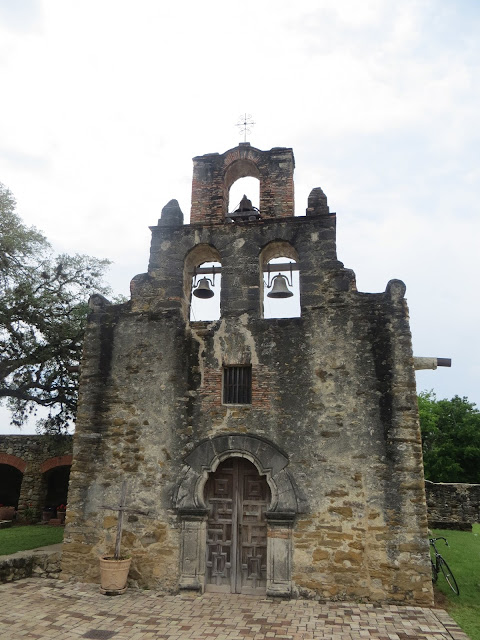Five Missions and a Riverwalk
July 04, 2017
We don't always immediately post about places that we visited. So our posts, when we do remember to write them, are often out of chronological order. We hope you don't mind. I (Steve) was looking at our blog recently and realized that while we had traveled from Florida across the south to Arizona, we hadn't written about any of the places that we'd seen. We skipped right over New Orleans, all of Texas, Carlsbad Caverns, and Las Cruces. I'll address one of these now with some thoughts about San Antonio.
San Antonio is famous for a few things, most notably the Alamo and the Riverwalk. The Alamo was a Spanish mission, one of many that dotted the southwest. The missions were typically spaced one day's walk apart, and so San Antonio actually has five missions. We stayed in an RV park that was located on the Riverwalk, between a couple missions and about five miles from the Alamo. The Riverwalk extends way beyond the downtown area as a bike and walking path along the river. We could have ridden our bikes right into the downtown area, but as securing bikes is challenging, we opted to ride the city bus that stopped right in front of our park.
The fvie missions are the Alamo (Mission San Antonio de Valero), Mission Concepcion, Mission San Jose, Mission San Juan, and Mission Espada. Mission Concepcion, pictured above, is probably the prettiest of the group. The interior is nicely maintained, and it has a large lawn in front of it.
The missions are all still active congregations, so while the sites are part of the National Park Service, the insides are taken care of by the local congregation. It makes for an interesting mix.
Mission San Jose is the most complete - with most of the grounds intact. These grounds included sleeping quarters for the residents, workshops, storage for foodstuffs, and a wall to enclose the entire compound.
The Spanish were looking to populate the new world that they had claimed, and the quickest way to accomplish this was to convert the local Native population. Finding food in the desert southwest can be challenging at certain times of the year, particularly for hunter/gatherer groups. The Spanish brought agriculture, food storage, tool making, and other technologies that enabled the missions to have a steady food supply. This made it relatively easy to recruit local people to work in the missions. In exchange for pledging their allegiance to the king of Spain, adopting the Catholic religion, giving up their culture, and agreeing to work for the mission, they got three meals a day and a place to live. Mission San Jose does a good job of showing a glimpse of what that life might have been like.
The other two missions are fairly small, and the buildings aren't open much for visiting, but they are worth stopping by if you have the time.
The Riverwalk is a quite a contrast to the missions. The missions, with the exception of the Alamo, were not crowded with tourists when we were there, and were quite serene peaceful places that gave us a view of our history. The Riverwalk is all about commerce, with lots of restaurants, cafes, shops, and hotels. There is history there about controlling the flooding that used to occur. You'll learn it best from a boat tour. The best way to see the Riverwalk is to not walk, as there are tourists jammed everywhere. Ride the boats that ply the waters of the river and you'll have a more enjoyable time.
Here's Steve enjoying his first senior discount.
We enjoyed San Antonio. We were there only four nights, so I'm sure that there is much more to see. But we'll have to save that for another day.
--Steve















0 comments